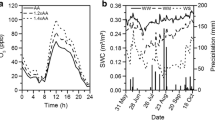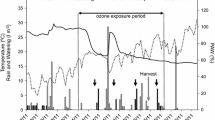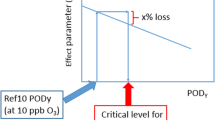Abstract
Ozone (O3) critical levels have been established under the Long-Range Transboundary Air Pollution Convention to assess the risk of O3 effects in European vegetation. A recent review study has led to the development of O3 critical levels for annual Mediterranean pasture species using plants growing in well-watered pots at a coastal site and under low levels of competition. However, uncertainties remain in the extrapolation of the O3 sensitivity of these species under natural conditions. The response of two O3-sensitive annual Mediterranean pasture Trifolium species at the coastal site was compared with the response of the same species growing at a continental site, in natural soil and subject to water-stress and inter-specific competition, representing more closely their natural habitat. The slopes of exposure- and dose-response relationships derived for the two sites showed differences in the response to O3 between sites attributed to differences in environmental growing conditions, growing medium and the level of inter-specific competition, but the effect of the individual factors could not be assessed separately. Dose-based O3 indices partially explained differences due to environmental growing conditions between sites. The slopes showed that plants were more sensitive to O3 at the continental site, but homogeneity of slopes tests revealed that results from both experimental sites may be combined. Although more experimental data considering complex inter-specific competition situations and the effect of important interactive factors such as nitrogen would be needed, these results confirm the validity of applying the current flux-based O3 critical level under close to natural growing conditions. The AOT40-based O3 critical level derived at the coastal site was also considered a suitable risk indicator in close to natural growing conditions in the absence of soil moisture limitations on plant growth.

Similar content being viewed by others
References
Alonso R, Elvira S, Castillo FJ, Gimeno BS (2001) Interactive effects of ozone and drought stress on pigments and activities of antioxidative enzymes in. Plant Cell Environ 24:905–916. doi:10.1046/j.0016-8025. 2001.00738.x
Alonso R, Elvira S, González-Fernández I et al (2014) Drought stress does not protect Quercus ilex L. from ozone effects: results from a comparative study of two subspecies differing in ozone sensitivity. Plant Biol 16:375–384. doi:10.1111/plb.12073
Bassin S, Käch D, Valsangiacomo A et al (2015) Elevated ozone and nitrogen deposition affect nitrogen pools of subalpine grassland. Environ Pollut 201:67–74. doi:10.1016/j.envpol. 2015.02.038
Bassin S, Volk M, Fuhrer J (2007) Factors affecting the ozone sensitivity of temperate European grasslands: an overview. Environ Pollut 146:678–691. doi:10.1016/j.envpol. 2006.06.010
Black VJ, Black CR, Roberts JA, Stewart CA (2000) Impact of ozone on the reproductive development of plants. New Phytol 147:421–447. doi:10.1046/j.1469-8137. 2000.00721.x
Büker P, Feng Z, Uddling J et al (2015) New flux based dose - response relationships for ozone for European forest tree species. Environ Pollut 206:163–174. doi:10.1016/j.envpol. 2015.06.033
Bungener P, Nussbaum S, Grub A, Fuhrer J (1999) Growth response of grassland species to ozone in relation to soil moisture condition and plant strategy. New Phytol 142:283–293. doi:10.1046/j.1469-8137. 1999.00389.x
Calatayud V, Cerveró J, Calvo E et al (2011) Responses of evergreen and deciduous Quercus species to enhanced ozone levels. Environ Pollut 159:55–63. doi:10.1016/j.envpol. 2010.09.024
Calvete-Sogo H, Elvira S, Sanz J et al (2014) Current ozone levels threaten gross primary production and yield of Mediterranean annual pastures and nitrogen modulates the response. Atmos Environ 95:197–206. doi:10.1016/j.atmosenv. 2014.05.073
Calvete-Sogo H, González-Fernández I, García-Gómez H et al (2017) Developing ozone critical levels for multi-species canopies of Mediterranean annual pastures. Environ Pollut 220:186–195. doi:10.1016/j.envpol. 2016.09.038
Calvete-Sogo H, González-Fernández I, Sanz J et al (2016) Heterogeneous responses to ozone and nitrogen alter the species composition of Mediterranean annual pastures. Oecologia 181:1055–1067. doi:10.1007/s00442-016-3628-z
CLRTAP (2017) Manual in methodologies and criteria for modelling and mapping critical loads and levels and air pollution effects, risks and trends. Chapter 3, Mapping critical levels for vegetation. Convention on long-range transboundary air pollution. Available at: http://icpmapping.org/Latest_update_Mapping_Manual
Cristofanelli P, Bonasoni P (2009) Background ozone in the southern Europe and Mediterranean area: influence of the transport processes. Environ Pollut 157:1399–1406. doi:10.1016/j.envpol. 2008.09.017
Davison AW, Barnes JD (1998) Effects of ozone on wild plants. New Phytol 139:135–151. doi:10.1046/j.1469-8137. 1998.00177.x
Di Gregorio A, Jansen LJM (2000) Land cover classification system (LCCS): classification concepts and user manual. Food and Agriculture Organization, Rome ISBN 92-5-104216-0. Available at: http://www.fao.org/docrep/003/x0596e/X0596e00.htm#P-1_0
EEA (European Environment Agency) (2014) Air quality in Europe −2014 report. Technical report no. 5/2014. European Environmental Agency, Copenhagen. doi:10.2800/22775
Emberson LD, Ashmore MR, Cambridge HM et al (2000) Modelling stomatal ozone flux across Europe. Environ Pollut 109:403–413. doi:10.1016/S0269-7491(00)00043-9
Gimeno BS, Bermejo V, Sanz J et al (2004a) Growth response to ozone of annual species from Mediterranean pastures. Environ Pollut 132:297–306. doi:10.1016/j.envpol. 2004.04.022
Gimeno BS, Bermejo V, Sanz J et al (2004b) Assessment of the effects of ozone exposure and plant competition on the reproductive ability of three therophytic clover species from Iberian pastures. Atmos Environ 38:2295–2303. doi:10.1016/j.atmosenv. 2003.10.062
González-Fernández I, Bass D, Muntifering R et al (2008) Impacts of ozone pollution on productivity and forage quality of grass/clover swards. Atmos Environ 42:8755–8769. doi:10.1016/j.atmosenv. 2008.08.030
González-Fernández I, Bermejo V, Elvira S et al (2010) Modelling annual pasture dynamics: application to stomatal ozone deposition. Atmos Environ 44:2507–2517. doi:10.1016/j.atmosenv. 2010.04.033
González-Fernández I, Calvo E, Gerosa G et al (2014) Setting ozone critical levels for protecting horticultural Mediterranean crops: case study of tomato. Environ Pollut 185:178–187. doi:10.1016/j.envpol. 2013.10.033
Hayes F, Mills G, Ashmore M (2009) Effects of ozone on inter- and intra-species competition and photosynthesis in mesocosms of Lolium perenne and Trifolium repens. Environ Pollut 157:208–214. doi:10.1016/j.envpol. 2008.07.002
Heath RL, Lefohn AS, Musselman RC (2009) Temporal processes that contribute to nonlinearity in vegetation responses to ozone exposure and dose. Atmos Environ 43:2919–2928. doi:10.1016/j.atmosenv. 2009.03.011
Jarvis PG (1976) The interpretation of the variation in leaf water potential and stomatal conductance found in canopies in the field. Philos Trans R Soc Lond Ser B Biol Sci 273:593–610
Jones MLM, Hodges G, Mills G (2010) Nitrogen mediates above-ground effects of ozone but not below-ground effects in a rhizomatous sedge. Environ Pollut 158:559–565. doi:10.1016/j.envpol. 2009.08.002
Meleux F, Solmon F, Giorgi F (2007) Increase in summer European ozone amounts due to climate change. Atmos Environ 41:7577–7587. doi:10.1016/j.atmosenv. 2007.05.048
Mills G, Pleijel H, Braun S et al (2011) New stomatal flux-based critical levels for ozone effects on vegetation. Atmos Environ 45:5064–5068. doi:10.1016/j.atmosenv. 2011.06.009
Mills G, Buse A, Gimeno B et al (2007) A synthesis of AOT40-based response functions and critical levels of ozone for agricultural and horticultural crops. Atmos Environ 41:2630–2643. doi:10.1016/j.atmosenv. 2006.11.016
Monga R, Marzuoli R, Alonso R et al (2015) Varietal screening of ozone sensitivity in Mediterranean durum wheat (Triticum durum, Desf.) Atmos Environ 110:18–26. doi:10.1016/j.atmosenv. 2015.03.040
Nussbaum S, Bungener P, Geissmann M, Fuhrer J (2000) Plant-plant interactions and soil moisture might be important in determining ozone impacts on grasslands. New Phytol 147:327–335. doi:10.1046/j.1469-8137. 2000.00697.x
Payne RJ, Stevens CJ, Dise NB et al (2011) Impacts of atmospheric pollution on the plant communities of British acid grasslands. Environ Pollut 159:2602–2608. doi:10.1016/j.envpol. 2011.06.009
Sanz J, Bermejo V, Gimeno BS et al (2007) Ozone sensitivity of the Mediterranean terophyte Trifolium striatum is modulated by soil nitrogen content. Atmos Environ 41:8952–8962. doi:10.1016/j.atmosenv. 2007.08.016
Sanz J, Bermejo V, Muntifering R et al (2011) Plant phenology, growth and nutritive quality of Briza maxima: responses induced by enhanced ozone atmospheric levels and nitrogen enrichment. Environ Pollut 159:423–430. doi:10.1016/j.envpol. 2010.10.026
Sanz J, Calvete-Sogo H, González-Fernández I et al (2013) Foliar senescence is the most sensitive response to ozone in Bromus hordeaceus and is modulated by nitrogen input. Grass Forage Sci:1–14. doi:10.1111/gfs.12090
Sanz J, González-Fernández I, Calvete-Sogo H et al (2014) Ozone and nitrogen effects on yield and nutritive quality of the annual legume Trifolium cherleri. Atmos Environ 94:765–772. doi:10.1016/j.atmosenv. 2014.06.001
Sanz J, González-Fernández I, Elvira S et al (2016) Setting ozone critical levels for annual Mediterranean pasture species: combined analysis of open-top chamber experiments. Sci Total Environ. doi:10.1016/j.scitotenv. 2016.07.035
Sanz J, Muntifering RB, Bermejo V et al (2005) Ozone and increased nitrogen supply effects on the yield and nutritive quality of Trifolium subterraneum. Atmos Environ 39:5899–5907. doi:10.1016/j.atmosenv. 2005.06.022
Thwaites RH (1997) The effects of tropospheric ozone on calcareous grassland communities. PhD Thesis, University of London.
Volk M, Wolff V, Bassin S et al (2014) High tolerance of subalpine grassland to long-term ozone exposure is independent of N input and climatic drivers. Environ Pollut 189:161–168. doi:10.1016/j.envpol. 2014.02.032
Whitfield CP, Davison AW, Ashenden TW (1998) The effects of nutrient limitation on the response of Plantago major to ozone. New Phytol 140:219–230. doi:10.1046/j.1469-8137. 1998.00277.x
Wyness K, Mills G, Jones L et al (2011) Enhanced nitrogen deposition exacerbates the negative effect of increasing background ozone in Dactylis glomerata, but not Ranunculus acris. Environ Pollut 159:2493–2499. doi:10.1016/j.envpol. 2011.06.022
Acknowledgements
The experiments at the continental site were located at Finca Experimental Agrícola La Higueruela (MNCN-CSIC). This study was funded by projects AGRISOST (P2013/ABI-2717), Consejería de Educación, Cultura y Deporte, Comunidad de Madrid (Spain), and by the Spanish Ministry of Agriculture, Fisheries, Food and Environment (MAPAMA).
Author information
Authors and Affiliations
Corresponding author
Additional information
Responsible editor: Philippe Garrigues
Rights and permissions
About this article
Cite this article
González-Fernández, I., Sanz, J., Calvete-Sogo, H. et al. Validation of ozone response functions for annual Mediterranean pasture species using close-to-field-conditions experiments. Environ Sci Pollut Res 24, 26259–26268 (2017). https://doi.org/10.1007/s11356-017-9099-x
Received:
Accepted:
Published:
Issue Date:
DOI: https://doi.org/10.1007/s11356-017-9099-x




